|
Harper's New Monthly Magazine. European Edition, 1880–1966 | |
Sequence |
Volumes 7–11, 1883–86 |
Editor |
In America: |
Publisher |
In America: |
Printer |
Unknown |
Price |
1 s. (1880) |
Format |
Royal 8vo. |
Pages |
c. 170 (1880) |
Frequency |
Monthly |
Circulation |
10,000 (1880), 25,000 (1884) |
Indexes |
All volumes: Table of Contents, List of Illustrations |
Digital |
Digital copies of the US edition of Harper's Magazine, vols 1–98 (June 1850–May 1899) are available via http://onlinebooks.library.upenn.edu/webbin/serial?id=harpers. |
Copies |
Sheffield University Library (vols. 7–11) |
Introduction | |
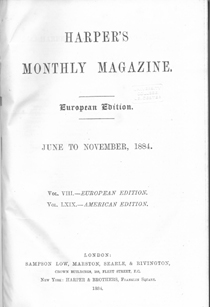
The American edition of Harper's New Monthly Magazine, which the successful New York publishing house Harper and Brothers brought out in 1850, was intended to both entertain and educate the 'great mass of the American people' with its appealing blend of fiction, travelogues, biographies, and droll social commentary, as well as occasional articles on topics like botany or sanitary engineering (quoted in Perkins 1985, p. 167). With its domestic circulation soon reaching an average of 110,000, Harper's, as a later editor claimed, could be considered as the very 'first truly popular magazine ...in America' ([Alden] 1884, pp. 165–66). The actual contents of the magazine, however, were, from the very start, almost entirely non-American, with Harper and Brothers taking advantage of the absence of international copyright laws and reprinting the work of bestselling British authors like Dickens and Thackeray at very little cost, while the magazine's regular news-digests largely excluded American news and instead kept readers abreast of political, social and cultural events on the other side of the Atlantic. When rival American periodicals accused Harper's of being 'anti-American in feeling' and mockingly dubbed it 'a good foreign magazine', Harper and Brothers responded by ensuring that their magazine became more identifiably American (quoted in Perkins 1985, p. 168). Harper's nevertheless retained extremely close ties to Britain, so that when a European edition of the magazine was launched in 1880 only minor modifications to the original American format were required. 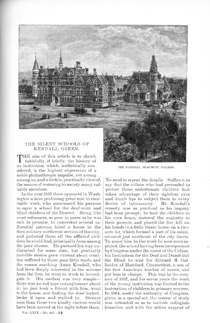
The objective of this ambitiously titled European edition (although in most business correspondence it was referred to as simply an English edition) was not only to increase the magazine's circulation, but also, as the Bookseller warned, to establish a foothold for the ambitious Harper and Brothers in the profitable British book publishing market (see Brake 1994, p. 106; Exman 1967, pp. 160–61). To facilitate the publication of the new European edition of Harper's, a complicated transatlantic arrangement was agreed between Richard Rogers Bowker, the London agent of Harper and Brothers, and the British publishing firm Sampson Low, Marston, Searle and Rivington. This stipulated that, in order to avoid British copyright laws, the majority of the magazine's pages would continue to be printed in America, although bearing the imprint of Sampson Low, and would then be shipped across the Atlantic ahead of the traditional magazine day at the end of each month, where appropriate adverts, and often some additional editorial material, would be hastily appended by the British publisher, who would also arrange for distribution and returns. A separate British editor was also appointed to commission new articles and contribute some exclusive material to the specifically British versions of the magazine's popular features 'Editor's Easy Chair', 'Editor's Literary and Historical Record', and 'Editor's Drawer'. However, as Laurel Brake has noted, the 'power base' of Harper's 'remained firmly in the US', and especially with its longstanding American editor Henry Mills Alden (1836–1919) (see Brake 1994, p. 107). Certainly, Andrew Lang (1844–1912), the most prominent of the British editors of Harper's, was constantly frustrated by his lack of real editorial influence, depicting himself as a mere 'atrophied organ' largely disregarded by those on the other side of the Atlantic (quoted in Demoor 1987, p. 417). Indeed, Lang's period as the British editor of Harper's was so ineffectual that scholars do not even agree on its duration, and it seems probable that he was dismissed in November 1885 after quarrelling with the leading contributor to the American edition William Dean Howells, only to return as editor sometime later, and then finally ended his involvement with the magazine in November 1889 (see Demoor 1987, p. 417; Brake 1994, p. 107). There is, moreover, no record of who, if anyone, succeeded Lang as the editor of the magazine's European edition. 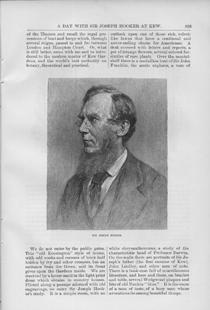
Despite such complications in the magazine's production, the European edition of Harper's successfully challenged the former hegemony of similarly priced home-grown journals like the Cornhill Magazine and Temple Bar, largely on account of the unmatched quality of the numerous illustrations which enlivened its double-column pages. The magazine's attractive format, its New York-based editor contended, had been honed by the more dynamic tastes of American readers, and it was, as a consequence, 'especially rich in papers of travel, exploration, and adventure. But its peculiar distinction is its illustration' (Alden 1884, p. 166). The superb parallel views of the skylines of London and New York (drawn by Alfred Parsons and Edwin A. Abbey respectively) that appeared on the wrappers of each monthly number impressed upon potential purchasers both the cosmopolitan nature of the contents as well as the superior quality of its illustrations. The success of Harper's, which was selling over 25,000 copies in Britain by the mid-1880s, signalled the growing internationalism of the British periodical marketplace during the final decades of the nineteenth century, but it also stoked widespread fears over America's impending commercial dominance. Perhaps in response to such anxieties, the magazine's American editor envisaged Harper's as a 'minister of ...international goodwill', suggesting that 'our kin beyond the sea, as they greet its familiar aspect, not as that of a stranger, but of a friend, will feel more deeply the community of ennobling tradition ...which unites America and England' (Alden 1884, p. 166). Such elaborately ecumenical sentiments, however, could not disguise how little Harper's was actually influenced by the involvement of either its British publishers, whose principal responsibility lay with advertising, or its largely superfluous British editor. Lang, when resigning his post in 1889, reflected that British writers' 'M.S.S. were never accepted' for the magazine, and he concluded that Harper and Brothers 'thought the game not worth the candle' (Demoor, ed. 1989, p. 102). The continued success of this almost wholly American-produced magazine in the British periodical marketplace, however, nevertheless endows the European edition of Harper's New Monthly Magazine with a certain uniqueness and fascination. | |
Notes on Indexing | |
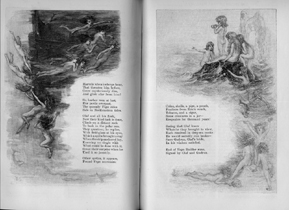
The format of the European edition of Harper's New Monthly Magazine was essentially the same as that of the original American edition, with the addition of a different wrapper, more relevant advertisements, and occasionally, but by no means always, exclusive editorial material that covered topics of specifically British interest. The pages produced in Britain and then appended to rest of the magazine that was sent over from America were printed on thinner, glossier paper, and also used a slightly smaller typeface. Harper's was notorious for its censorship of fictional writing, most notably an early version of Thomas Hardy's Jude the Obscure in 1894, and it was the house policy of Harper and Brothers to print only material that could be read aloud before all members of the family (see Perkins 1985, p. 168). Most aspects of contemporary science, technology and medicine, however, were featured regularly in the magazine, most notably in the optimistically titled 'Science and Progress' section of the monthly 'Editor's Historical Record', but also in the numerous travelogues, biographies, topical essays, and even the novels and stories, which Harper's carried. In successive issues in the autumn of 1884, for instance, the magazine featured lengthy profiles of Charles Darwin and Joseph Dalton Hooker, and, with an eye to patriotic readers back across the Atlantic, recorded how both men had expressed a particular delight with America and its people. At the same time, the long-running serialized novel Nature's Serial Story, which ran for twelve numbers during 1884 and 1885, used its sequential format to describe and explain the continuous seasonal changes within the natural environment of the Hudson Valley, including discussions of John Audubon's writings on ornithology and John Tyndall's researches on spontaneous generation, while also keeping less scientifically-minded readers interested in its protracted courtship plot (which was finally resolved with the help of a scientific analogy). The SciPer Index gives equal weight to all these different forms of scientific reference, and, with the exception of occasional obituary columns in which the death of a scientific practitioner is mentioned only in passing, all articles in which scientific subjects are mentioned, or even merely alluded to, have an interpretative summary. 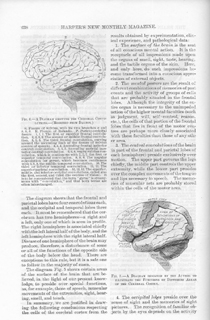
The Index covers the volumes of Harper's when Andrew Lang's involvement with the magazine, as editor of the European edition, can be known with certainty, i.e. from an unknown date in 1884 to November 1885 (see above). Lang was a prolific man of letters whose interests in anthropology and comparative philology, as well as many other broadly scientific subjects, are well known, and these topics feature prominently in the identifiably British editorial sections that appeared in Harper's during these years. Certainly, these sections, which were presumably penned by Lang though this cannot be known for certain, display an easy familiarity with the very latest developments in fields such as anthropology, ethnology, and comparative philology and mythology, and they often depart markedly from the avowed populism of the magazine's American publishers in discussing recondite and technical scientific details and in insisting on the need for specialist researchers. The 'Editor's Literary Record' in the November 1884 number, for instance, lambasted Friedrich Max Müller and Albert Réville for wasting their time lecturing on the history and evolution of religion to audiences whose 'interest is still, on the whole, thoroughly "popular" and unscientific', and complained that such scholars seemed 'content not to advance science, nor to consolidate it, but merely to popularise the elements of knowledge' ([Lang] 1884, p. 964). The erudite discussion of such specialist scientific matters in the editorial sections printed in Britain was frequently juxtaposed with eulogistic, and copiously illustrated, accounts from across the Atlantic of the scientific and technological aspects of America's rampant industrialisation and continued westward expansion, as exemplified by articles on 'The Drainage of the Everglades' and 'Modern Sanitary Engineering' which appeared in successive numbers during the spring of 1884. While the Index covers only four volumes of the European edition of Harper's New Monthly Magazine, it provides, amongst other things, a vivid insight into the information on international, and especially American, forms of science that was readily available to even the most parochially-minded readers of general periodicals in late Victorian Britain. | |
Bibliography | |
[Alden, Henry Mills] 1884. 'Editor's Easy Chair', Harper's New Monthly Magazine (European edition), 9, 165–68 Brake, Laurel 1994. 'Harper's New Monthly Magazine: American Censorship, European Decadence, and the Periodicals Market in the 1890s', in Subjugated Knowledges: Journalism, Gender and Literature in the Nineteenth Century, London: Macmillan, 104–24 Demoor, Marysa 1987. 'Andrew Lang Versus W. D. Howells: A Late-Victorian Literary Duel', Journal of American Studies, 21, 416–22 Demoor, Marysa, ed. 1989. Friends Over the Ocean: Andrew Lang's American Correspondents 1881–1912, Gent: Rijksuniversiteit te Gent Exman, Eugene 1967. The House of Harper: One Hundred and Fifty Years of Publishing, New York: Harper and Row Fleming, E. McClung 1952. R. R. Bowker: Militant Liberal, Norman: University of Oklahoma Press Harper, J. Henry. 1912. The House of Harper: A Century of Publishing in Franklin Square, New York: Harper and Brothers [Lang, Andrew]. 1884. 'Editor's Literary Record', Harper's New Monthly Magazine (European edition), 8, 964–69 Perkins, Barbara M. 1985. 'Harper's Monthly Magazine', in American Literary Magazines: The Eighteenth and Nineteenth Centuries, ed. by Edward E. Chielens, Historical Guides to the World's Periodicals and Newspapers, New York: Greenwood Press, 166–71 | |
Gowan Dawson | |